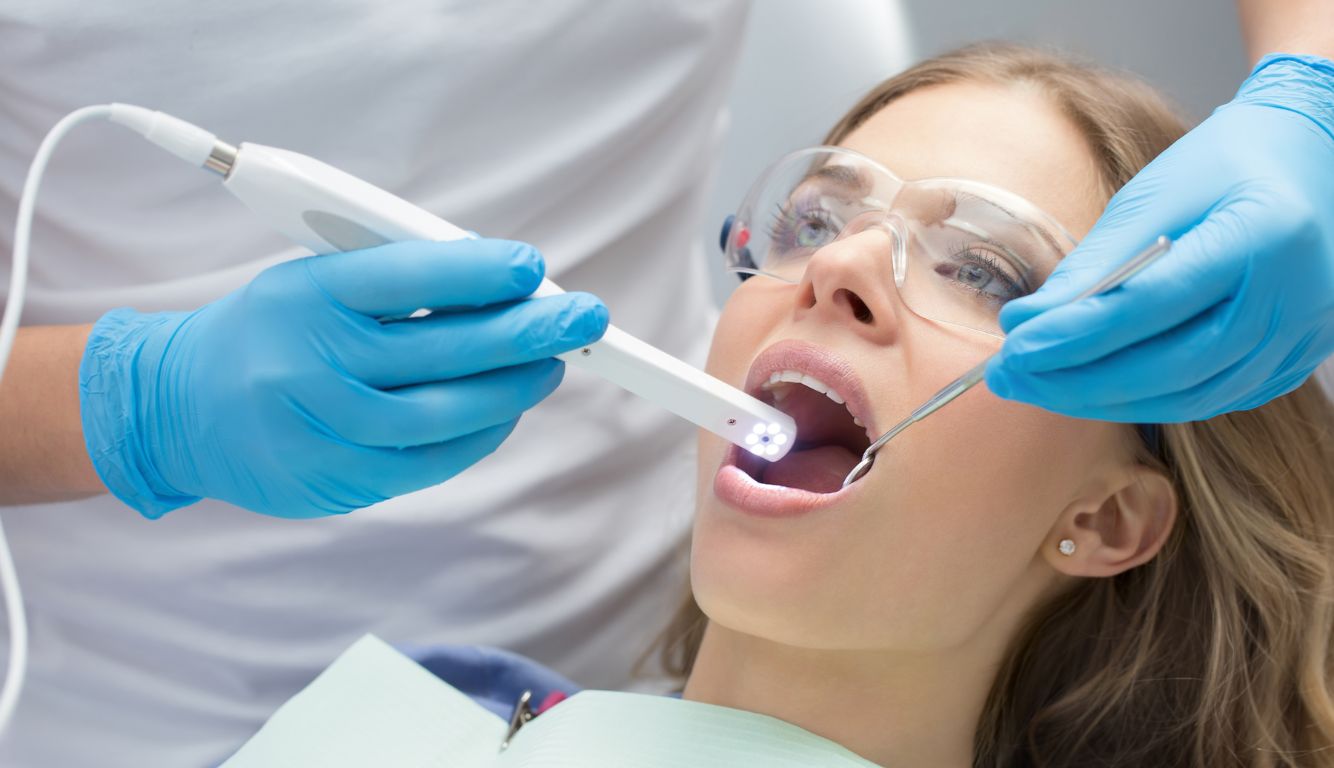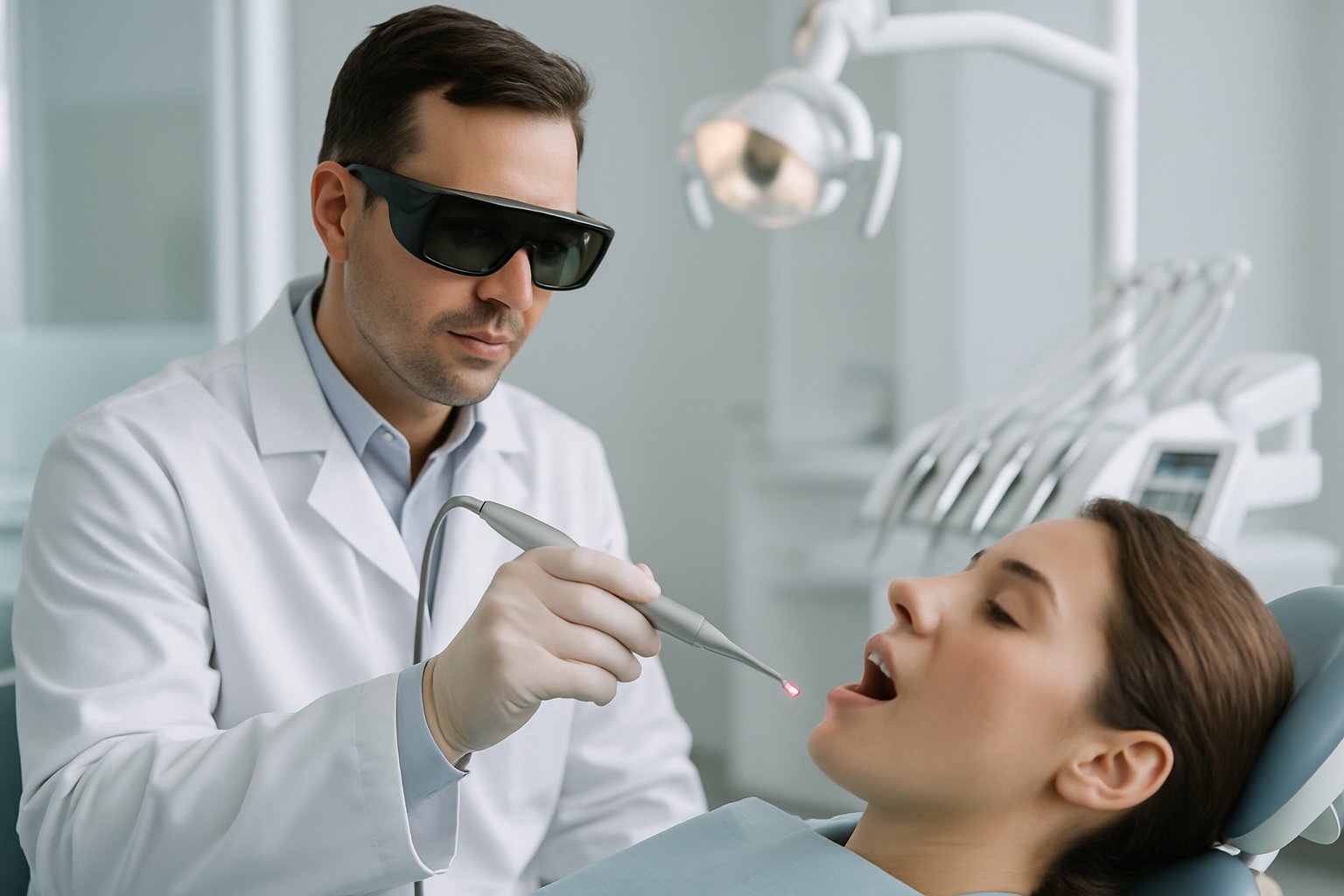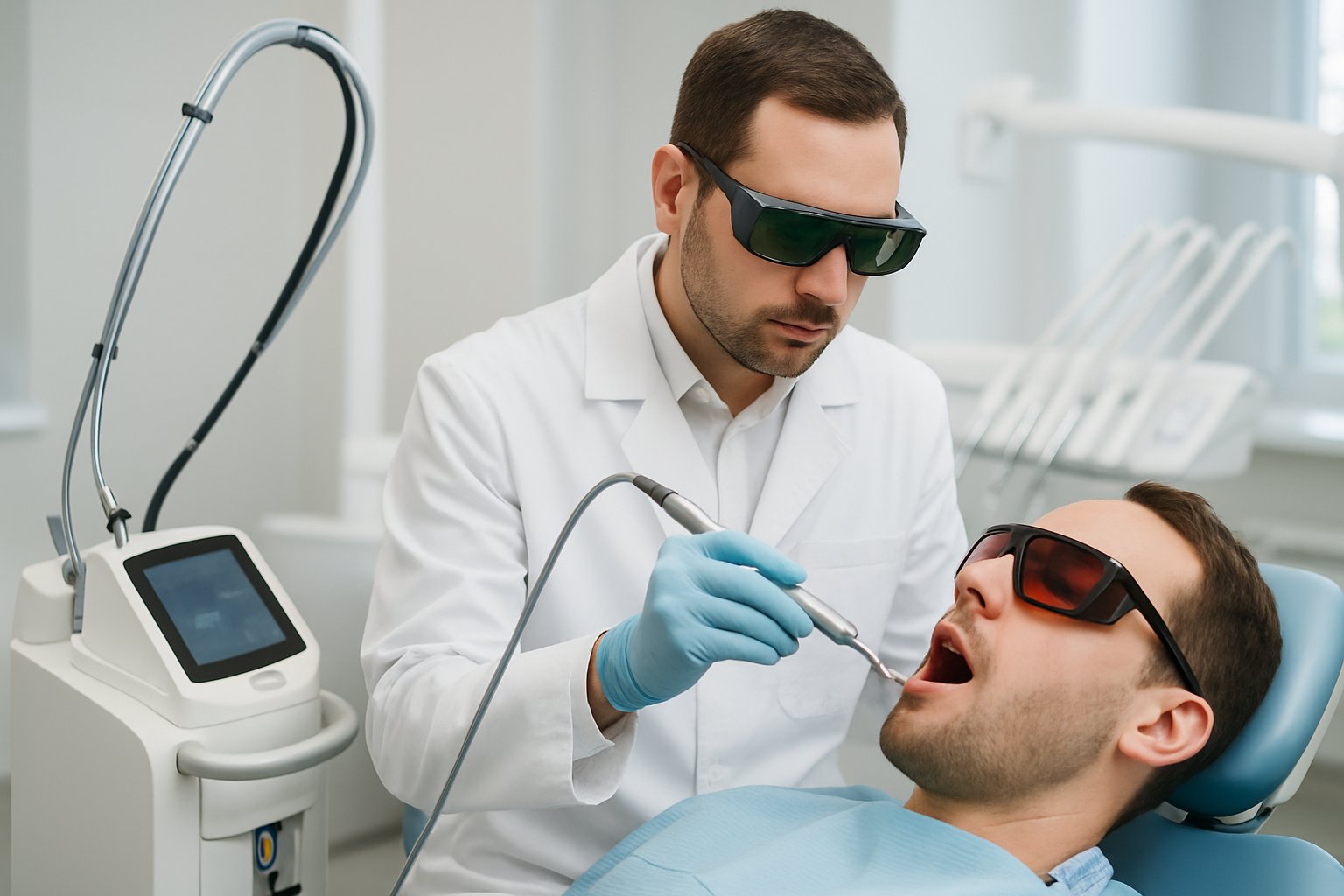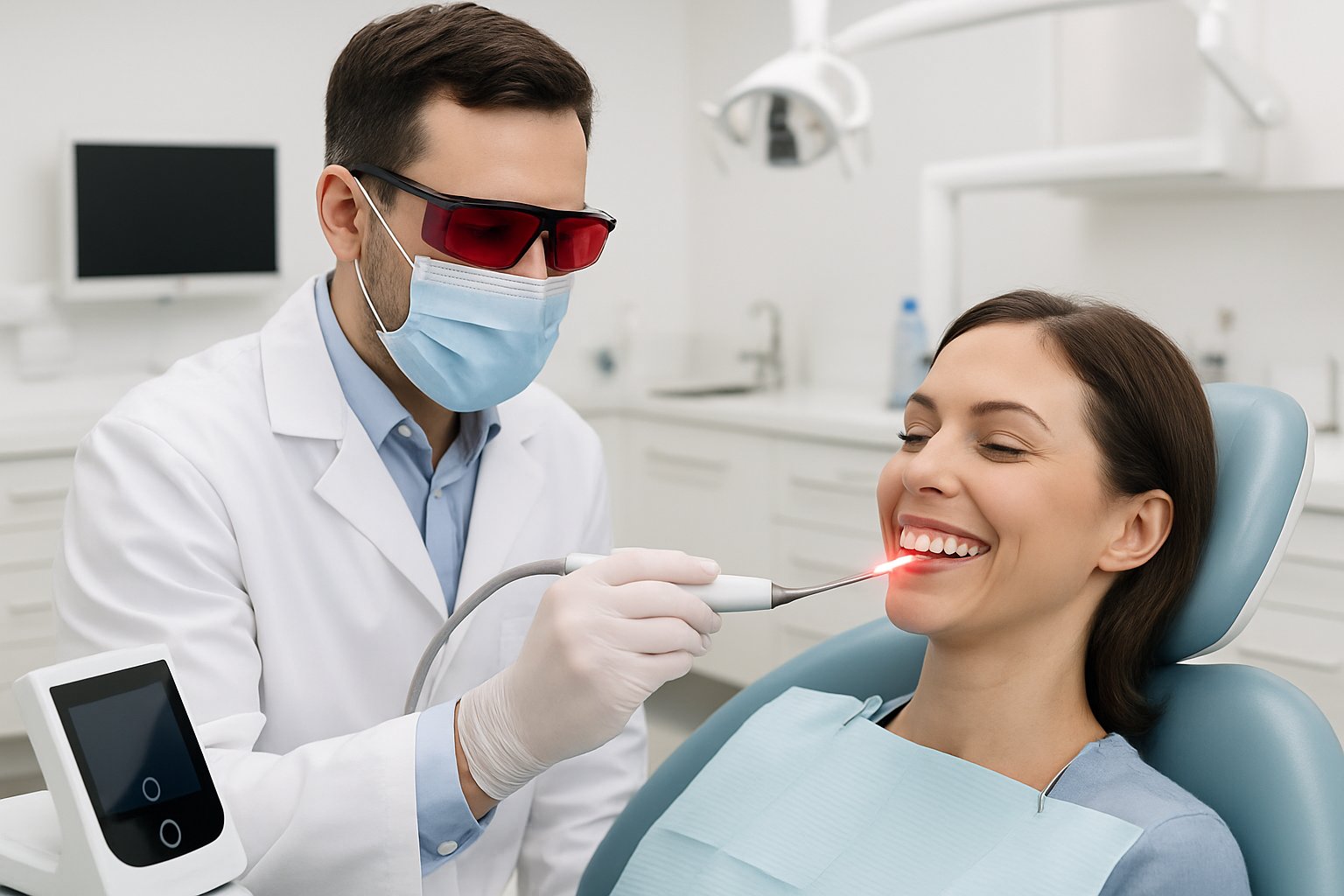What is Laser Dentistry?

Dental technology has changed how we treat teeth and gums.
Dentists use focused light beams in laser dentistry to perform many dental procedures with greater precision than traditional tools.
Many people wonder if laser dentistry is right for them.
This treatment works well for both routine cleanings and complex surgeries.
It often causes less pain and helps patients heal faster.
More dentists use lasers every year.
This technology treats gum disease, removes decay, and whitens teeth.
Most patients can benefit from laser dentistry, but some conditions work better with traditional methods.
Key Takeaways
- Laser dentistry uses light beams to treat teeth and gums with more precision than regular dental tools
- Most people can benefit from laser treatments, which often cause less pain and faster healing
- Dentists use lasers for many procedures including gum treatment, cavity removal, and teeth whitening
Understanding Laser Dentistry

Dentists use focused light beams in laser dentistry to treat dental problems instead of traditional tools like drills and scalpels.
Different types of dental lasers work for specific treatments.
This technology offers several advantages over older methods.
How Laser Dentistry Works
Dental lasers create focused light beams that target specific tissues in your mouth.
The laser energy removes or reshapes tissue with great precision.
Soft tissue lasers heat water molecules inside gum tissue, causing the tissue to vaporize instantly.
The laser seals blood vessels as it works, which reduces bleeding.
Hard tissue lasers target the water and minerals in your teeth.
These lasers can remove decay from tooth enamel and dentin.
They prepare teeth for fillings without using a drill.
The dentist controls the laser with a handheld device.
Dentists adjust the power and pulse duration for each treatment to control how much tissue they remove.
Types of Dental Lasers
Dentists use two main categories of dental lasers in practice.
Soft Tissue Lasers:
- Diode lasers
- CO2 lasers
- Nd lasers
Dentists use these lasers to treat gum disease, remove excess gum tissue, and perform biopsies.
They work well on soft tissues like gums and cheeks.
Hard Tissue Lasers:
- Erbium YAG lasers
- Erbium chromium YSGG lasers
Dentists use these lasers to cut through tooth enamel and bone.
They remove cavities, prepare teeth for fillings, and shape teeth.
Each laser type has specific wavelengths that target different tissues.
Dentists choose the right laser for your treatment needs.
Laser Technology vs. Traditional Methods
Laser technology offers several benefits over traditional dental procedures.
Pain and Discomfort: Traditional methods often require local anesthesia.
Many laser procedures need little or no numbing medication.
Bleeding and Swelling: Lasers seal blood vessels during treatment, reducing bleeding compared to scalpels and other tools.
Healing Time: Laser treatments usually heal faster than traditional procedures.
Precise cuts cause less trauma to surrounding tissue.
Accuracy: Dentists can target very specific areas with lasers, preserving more healthy tissue than traditional tools.
Infection Risk: The laser beam sterilizes the treatment area, lowering the chance of bacterial infections after your procedure.
However, some treatments still work better with traditional methods.
Complex procedures may require conventional tools alongside laser technology.
Common Laser Dental Procedures

Dentists use hard tissue lasers and soft tissue lasers for many dental treatments.
These procedures range from fixing cavities to cleaning root canals to changing how your gums look.
Cavity Removal and Repair
Hard tissue lasers remove decay from teeth without drilling.
The laser beam breaks down the decayed tooth material while leaving healthy tooth structure untouched.
This method causes less pain than traditional drilling.
Most patients need little to no numbing shots during cavity removal with lasers.
After removing the decay, dentists clean the area and place a filling.
The laser also prepares the tooth surface for bonding materials.
Benefits of laser cavity removal:
- Less vibration and noise
- Reduced bleeding
- Faster healing time
- More precise removal of decay
The process takes about the same time as regular drilling.
Dentists can treat multiple cavities in one visit using laser technology.
Gum Reshaping and Contouring
Soft tissue lasers reshape gums that are too high or uneven.
This procedure fixes a “gummy smile” where too much gum shows when you smile.
Dentists use the laser to remove excess gum tissue and sculpt the gum line.
The laser seals blood vessels as it cuts, which means less bleeding during treatment.
Gum contouring also helps when gums cover too much of the tooth.
Dentists can expose more of the tooth surface to make teeth look longer and more even.
The laser cauterizes the tissue as it works.
This reduces swelling and helps the gums heal faster than traditional surgery.
Most patients return to normal activities within 24 hours.
Dentists may recommend soft foods for a few days after gum reshaping.
Teeth Whitening Applications
Lasers speed up teeth whitening treatments in the dental office.
Dentists apply a whitening gel to your teeth and use laser light to activate the bleaching agents.
The laser heat helps the whitening gel penetrate tooth stains more deeply.
This process can lighten teeth by several shades in one appointment.
Treatment usually takes 60 to 90 minutes.
Dentists apply the gel and use the laser in three 15-minute cycles with fresh gel each time.
Laser whitening results:
- Teeth can get 3-8 shades whiter
- Results last 1-3 years
- Works on most surface stains
- Safe for tooth enamel
Some patients feel tooth sensitivity for a day or two after laser whitening.
This temporary side effect goes away on its own.
Root Canal Therapy
Dentists use lasers during root canals to clean and sterilize the inside of tooth roots.
The laser kills bacteria that regular cleaning might miss.
Hard tissue lasers remove infected tissue from inside the tooth.
Soft tissue lasers disinfect the root canal system and help seal the area.
This technology makes root canals more successful.
The laser eliminates more bacteria than traditional methods.
Laser-assisted root canals often heal faster.
Patients usually have less pain and swelling after treatment.
Dentists still use the same basic root canal steps.
The laser adds an extra level of cleaning and sterilization.
Benefits and Suitability of Laser Dentistry

Laser dentistry offers several advantages over traditional dental methods.
Patients experience faster healing, less pain and bleeding, and reduced infection risk.
Faster Healing and Recovery
Laser treatments speed up healing compared to traditional dental tools.
The laser energy helps blood vessels close quickly during procedures.
This means less swelling and faster tissue repair.
Most patients see their gums heal within 24 to 48 hours after laser treatment.
Recovery times:
- Gum treatments: 1-2 days
- Cavity preparation: Same day
- Soft tissue procedures: 2-3 days
Traditional methods often require 5-7 days for similar healing.
The laser also removes bacteria during treatment, which helps tissues heal faster.
Reduced Pain and Bleeding
Laser dentistry causes much less pain than traditional methods.
The laser seals nerve endings as it works, which blocks pain signals.
Many patients need little or no numbing shots during laser procedures.
The laser also seals blood vessels right away, so there is very little bleeding.
Pain reduction benefits:
- Less need for pain medicine after treatment
- Fewer numbing shots required
- Almost no bleeding during procedures
- Less soreness the next day
Laser dentistry works well for people with dental anxiety.
The quiet operation and gentle treatment help patients feel more comfortable.
Lower Risk of Infection
Laser energy kills bacteria and germs during dental procedures.
This creates a sterile treatment area that prevents infections from starting.
The laser sterilizes the treatment site better than traditional cleaning methods.
Patients have a much lower chance of getting infections after laser procedures.
The heat from the laser destroys harmful bacteria that cause gum disease and tooth decay.
This benefit is especially important for patients with weak immune systems or diabetes.
These patients often struggle with healing and fighting off infections.
Who Can Benefit from Laser Dentistry
Most dental patients can safely receive laser treatments.
People with dental anxiety often prefer laser dentistry because it is quieter and more comfortable.
Best candidates:
- Patients afraid of dental drills
- People who want faster healing
- Those with bleeding disorders
- Patients with gum disease
- Children who need gentle treatment
Some patients cannot have laser treatments.
People with certain heart conditions or those taking specific blood thinners may need traditional methods instead.
Pregnant women should wait until after delivery for non-emergency laser procedures.
Dentists always review each patient’s medical history before recommending laser treatment.
Laser dentistry works well for most oral health needs, from simple cleanings to complex gum surgery.
Special Considerations and Advanced Applications
Laser dentistry goes beyond basic treatments to include complex soft tissue procedures and specialized surgeries.
Dental professionals use lasers for precise gum surgery, tissue removal, and diagnostic procedures that require minimal invasiveness.
Soft Tissue Treatments and Surgeries
Gum disease treatment is a common application of laser therapy in dentistry.
Dentists use lasers to remove infected tissue and bacteria from periodontal pockets without cutting into healthy gums.
The laser energy kills harmful bacteria while helping the surrounding tissue heal.
This approach reduces bleeding and swelling compared to traditional gum surgery.
Crown lengthening procedures also benefit from laser technology.
Dentists can reshape gum tissue precisely to expose more of the tooth structure for restorative work.
Laser gum surgery usually requires less anesthesia than conventional methods.
Patients experience less discomfort and faster healing.
Key advantages:
- Minimal bleeding during procedures
- Reduced need for sutures
- Lower risk of infection
- Faster tissue regeneration
Frenectomy and Biopsies
Frenectomy procedures using lasers work well for both children and adults.
Dentists remove or modify the tissue connecting the lip to the gum or the tongue to the floor of the mouth.
Laser frenectomy eliminates the need for scalpels and reduces healing time.
The procedure typically takes 10-15 minutes with immediate tissue sealing.
Tissue biopsies performed with lasers allow for greater precision.
Dentists can remove small tissue samples while minimizing damage to surrounding areas.
The laser cauterizes blood vessels during tissue removal, creating a clean surgical site.
This reduces bleeding and provides better visibility for the procedure.
Benefits for these procedures:
- No sutures required in most cases
- Immediate bleeding control
- Reduced scarring
- Same-day return to normal activities
Laser Dentistry in Los Angeles
Los Angeles dental practices have widely adopted laser technology due to patient demand for advanced treatments.
More specialists now offer comprehensive laser services.
The competitive dental care market in Los Angeles drives innovation in laser applications.
Many practices invest in multiple laser systems to handle different treatment needs.
Insurance coverage for laser procedures varies among Los Angeles providers.
Check with your dental insurance before scheduling advanced laser treatments.
Most major dental groups in the Los Angeles area now include laser therapy as a standard treatment option.
This makes advanced procedures available to more patients seeking modern dental care.
Frequently Asked Questions
Laser dentistry offers precise treatment options with reduced pain and faster healing times.
Costs vary by procedure type, and insurance coverage depends on medical necessity and specific policy terms.
What are the benefits and drawbacks of using laser dentistry?
Laser dentistry offers several key benefits for patients. Lasers seal blood vessels as they cut, so bleeding during procedures drops.
Pain levels are often much lower, which can eliminate the need for local anesthesia. Healing is faster because the laser sterilizes the area and reduces infection risk.
Patients experience less swelling and discomfort after procedures compared to traditional methods.
However, laser dentistry also has drawbacks. Equipment costs are high, so treatments are often more expensive.
Not all dental procedures can use laser technology. Some dentists do not have proper laser training, which limits where patients can get these treatments.
How does laser dentistry differ from traditional dental techniques?
Traditional dentistry uses drills, scalpels, and other mechanical tools. These methods often require shots to numb the area.
Bleeding and swelling are common after treatment. Laser dentistry uses focused light beams instead of cutting tools.
The laser removes decay or cuts tissue with great precision. Most procedures need little or no numbing medication.
Recovery time is shorter with lasers. Lasers often seal wounds automatically, so stitches are not needed.
Patients feel less pain and can return to normal activities sooner.
Can laser dental treatments be covered by insurance policies?
Insurance coverage for laser dentistry depends on the procedure. Most plans cover laser treatments when they replace medically necessary traditional procedures.
Routine cleanings and cavity fillings with lasers are often covered. Cosmetic laser procedures, such as gum reshaping for appearance or teeth whitening, usually are not covered.
Patients should contact their insurance provider before treatment. Coverage varies widely between insurance companies and plan types.
What types of procedures can be performed with dental lasers?
Dental lasers can treat both hard and soft tissues in the mouth. Soft tissue procedures include gum disease treatment and removing excess gum tissue.
Dentists use lasers to treat cold sores and remove small growths. Hard tissue procedures focus on teeth and bone.
Lasers remove tooth decay and prepare teeth for fillings. Dentists can also reshape bone during some oral surgeries.
Laser technology helps with root canal procedures by cleaning and sterilizing tooth roots. Some dentists use lasers to whiten teeth or reduce tooth sensitivity.
What should patients expect in terms of cost for laser dental treatments?
Laser dental treatments usually cost more than traditional methods. The price difference is often 10% to 50% higher, depending on the procedure.
Simple cavity treatments may add $50 to $100 to the total cost. Complex procedures like gum disease treatment can cost several hundred dollars more.
The exact price depends on treatment time, the type of laser used, and the geographic location. Many patients feel the higher cost is worthwhile because of reduced pain and faster healing.
Are there any risks or side effects associated with laser dentistry?
Laser dentistry usually involves fewer risks than traditional dental procedures. Lasers sterilize the treatment area, which lowers infection rates.
Most patients experience minimal bleeding and swelling. Some people may notice temporary tooth sensitivity after treatment.
This sensitivity often goes away within a few days. In rare cases, soft tissues may receive minor burns.
Dentists can damage healthy tissue if they use lasers improperly. Choose a dentist who has proper laser training and certification.
Always wear eye protection during laser procedures to prevent vision damage.
📞 Contact Kaufman Dentistry Today
Give us a call at (310) 838-7780 to schedule your appointment and take the first step towards a stunning smile.
You can find us at 10760 Washington Blvd., Culver City, CA 90232. We look forward to welcoming you to our practice and helping you achieve the smile of your dreams!
